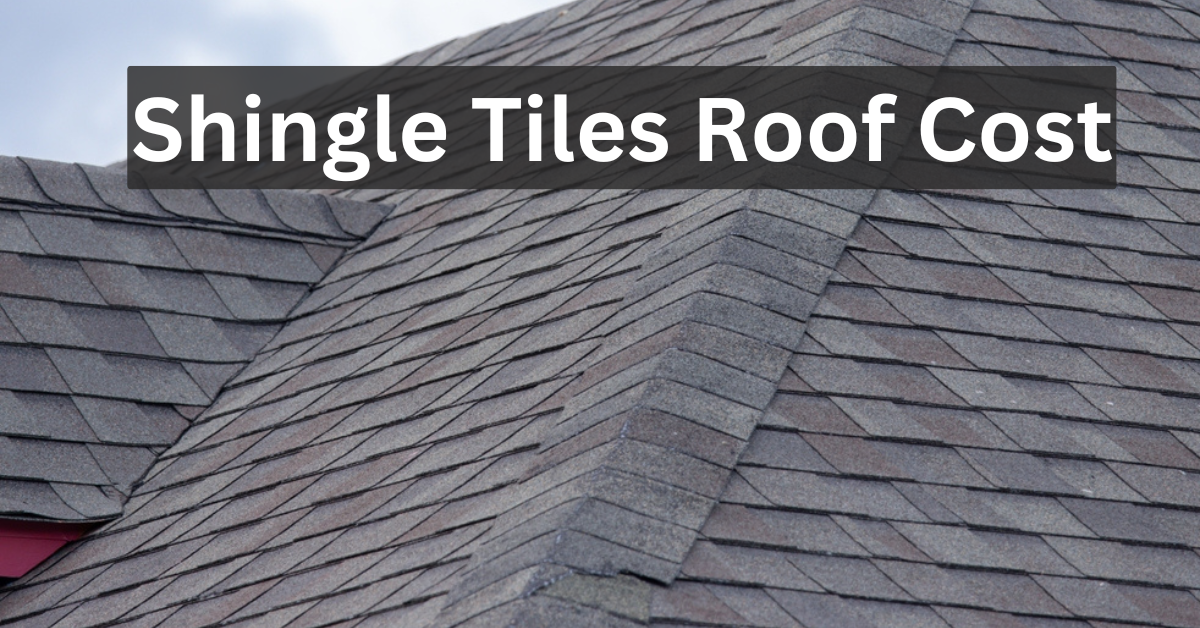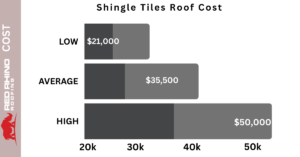
Shingle tiles are versatile and aesthetically pleasing roofing materials, and the shingle tiles roof cost has become a key factor in their popularity due to their durability, energy efficiency, and variety of designs. Suitable for both commercial and residential roofing, they offer a reliable and attractive solution for various building types. In this article, we explore everything you need to know about shingle tile roof costs and the factors influencing the price of shingle roof tiles.

| Cost Type | Price |
| Average Cost | $35,500 |
| Highest Cost | $50,000 |
| Lowest Cost | $21,000 |
Types of Shingle Tile Roofs with Costs
Shingle tiles are individual roofing pieces designed to overlap and create a watertight and protective layer for your home. They are often made from materials such as clay, concrete, slate, or composite. Shingle tiles are an attractive roofing option due to their variety of colors, textures, and durability. Below is a table summarizing the shingle roof tiles costs based on different materials:
| Cost Type | Cost per Square Foot (Material) | Cost per Square Foot (Installed) |
| Clay Tile Shingles | $2.50 to $18 | $8 to $25 |
| Concrete Tile Shingles | $3 to $5 | $7 to $19 |
| Slate Tile Shingles | $10 to $30 | $3 and $30 |
Note: Costs may vary based on geographical location and labor charges.
Factors Influencing Shingle Tiles Roof Cost
Shingle tiles are individual roofing pieces designed to overlap and create a watertight and protective layer for your home. They are often made from materials such as clay, concrete, slate, or composite. Shingle tiles are an attractive roofing option due to their variety of colors, textures, and durability.
The cost of a tile shingle roof depends on several key factors:
Material Type: The type of material—such as clay, concrete, slate, or composite—significantly impacts costs. Durable materials like slate are more expensive, while concrete and composite options are more affordable.
Roof Size: Larger roofs increase the total cost as roofing prices are calculated per square foot, requiring more material and labor.
Labor Costs: Labor costs vary by region and contractor expertise. Tile shingle roofs often require skilled labor for proper installation.
Roof Complexity: Features such as steep slopes, skylights, or chimneys can increase the complexity of installation, leading to higher costs.
Location: Material and labor costs are typically higher in urban areas or regions with a high cost of living due to demand and logistics.
Climate Considerations: Certain climates may require specific materials, such as tiles designed for extreme heat or freeze-thaw cycles, which can increase costs.
Installation vs. Replacement: Installing a new roof is generally less expensive than replacing an old one, which involves additional costs for removing and disposing of existing materials.
Customization and Color: Custom colors, finishes, or unique designs add to the overall cost.
Permits and Regulations: Adhering to building codes and obtaining permits can add to the overall expense of the project.
Additional Features: Optional upgrades like waterproofing, ridge caps, or enhanced insulation increase the cost but improve the roof’s performance and longevity.
The cost of tile shingle roofs is influenced by a combination of these factors, making it important for homeowners to consider their specific needs and circumstances when budgeting for a roofing project.
Benefits of Tile Shingle Roofs
Tile shingles are a popular roofing choice for homeowners due to their unique blend of beauty, durability, and functionality. While the shingle tile roofs cost might initially seem higher than other materials, their long-term benefits make them a worthwhile investment. Below are the key advantages of using tile shingles for your roofing project.
| Benefit | Description |
| Exceptional Durability | Tile shingles last 50+ years, with natural slate lasting up to 100 years. |
| Weather Resistance | Designed to withstand harsh weather, including fire resistance in wildfire-prone areas. |
| Energy Efficiency | Excellent insulation, reducing heat absorption and improving indoor temperature regulation. |
| Low Maintenance | Resistant to mold, rot, and pests, requiring minimal upkeep. |
| Aesthetic Appeal | Offers a timeless, elegant look with various styles, colors, and textures. |
| Eco-Friendly Option | Made from natural, recyclable materials, reducing waste over time. |
| Increased Property Value | Adds resale value due to durability, aesthetic appeal, and energy efficiency. |
| Fire Resistance | Naturally fire-resistant, which may lower homeowner’s insurance premiums. |
| Noise Reduction | Provides excellent sound insulation, reducing noise from rain, hail, etc. |
| Adaptability to Climate | Reflects sunlight in hot climates and withstands snow in colder regions. |
| Customizable Options | Available in various shapes, colors, and finishes, mimicking other materials like wood. |
Shingles Tile Roof Lifespan
When choosing roofing materials, the lifespan of shingles and tile roofs plays a crucial role in determining their overall value. Different materials offer varying levels of durability, which directly impacts both their long-term cost-effectiveness and maintenance needs. Here’s a breakdown of common roofing materials and their expected lifespans:
| Material | Lifespan |
| Asphalt Shingles | 15 – 30 yrs |
| Clay Tile Shingles | 50+ yrs |
| Slate Tile Shingles | 100+ yrs |
How to Choose the Right Tile Shingles for Roofing
To make the best decision for your roofing project, consider the following:
- Budget: Determine your maximum spend, keeping in mind that premium materials like slate offer long-term value.
- Aesthetic Goals: Choose a material and color that complements your home’s architecture.
- Climate Considerations: In areas with heavy rainfall, clay or slate tiles perform exceptionally well.
- Installation Partner: Opt for professional contractors to ensure proper installation and longevity.
Shingle Tile Roofs Cost Comparison for Different Materials
The cost of a shingle roof varies significantly based on the material you select. From budget-friendly asphalt shingles to high-end slate options, each type has its own pricing structure. It’s crucial to understand the cost differences between materials to make an informed decision for your roofing project.
Here’s a breakdown of installation costs and expected lifespans for various shingle types:
| Shingle Type | Cost per Square Foot (Materials) | Cost per Square Foot (Installed) | Average Lifespan |
| Asphalt Shingles Cost | $80 – $280 | $200 – $700 | 15 – 20 years |
| Solar Shingle cost | $20 – $30 | $21 – $40 | 25 – 40 years |
| Wood Shingles and Shakes Cost | $3.50 – $5.50 | $6.00 – $14.30 | 20 – 40 years |
| Metal Shingles Cost | $3.50 – $5.50 | $10.00 – $25.00 | 40 – 70 years |
| Slate Shingles Cost | $10.00 – $20.00 | $12.00 – $30.00 | 75 – 100 years |
| Composite Shingles Cost | $3.00 – $5.00 | $8.00 – $15.00 | 30 – 50 years |
| Tile Shingles Cost | $6.00 – $10.00 | $10.00 – $20.00 | 50 – 100 years |
Conclusion
While the tile shingles roof cost may initially be higher than other roofing materials, the long-term benefits far outweigh the expense. From durability and energy efficiency to aesthetic appeal and weather resistance, tile shingles provide a reliable and attractive roofing solution for homeowners. Investing in tile shingles not only enhances your home’s appearance but also ensures lasting protection and value for decades.
Frequently Asked Questions
Shingle tile roofs are typically made from materials like clay, concrete, slate, or composite. These materials offer durability, aesthetic variety, and weather resistance.
The cost varies based on the material and installation. On average, clay tile shingles range from $8 to $25 per square foot installed, while concrete tiles cost between $7 and $19 per square foot installed.
Shingle tile roofs are highly durable, with clay tiles lasting 50+ years and slate tiles lasting up to 100 years or more, depending on maintenance.
Yes, shingle tile roofs provide excellent insulation, reducing heat absorption and maintaining indoor temperatures, which helps lower energy costs.
Factors include material type, roof size, labor costs, roof design complexity, location, and any additional customizations or upgrades like waterproofing or ridge caps.


